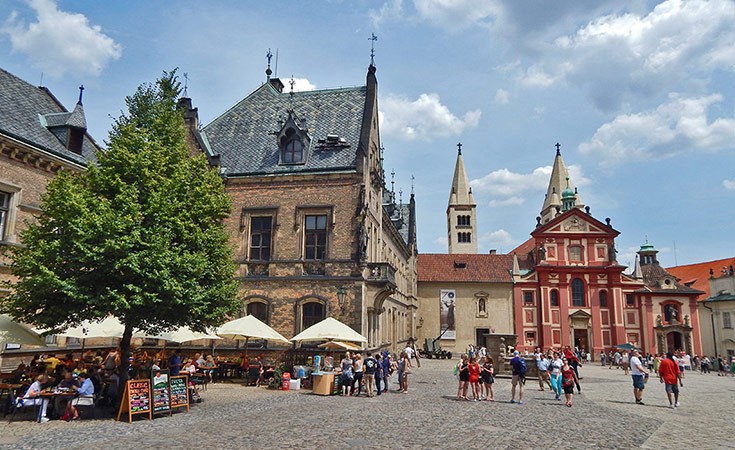
Prague Castle is on the must-see lists for anyone that visits Prague. This enormous structure that dominates Prague’s skyline was the seat of rulers and presidents of these lands for centuries. Apart from St Vitus Cathedral, there are many museum and monuments that can be visited within the castle.
Prague Castle is one of three major tourist attractions of Prague (other being: Charles Bridge and Astronomical Clock) that dominates Prague’s skyline. It consists of three sections (courtyards). In the third courtyard there is a beautiful St Vitus Cathedral - the largest, most important and most beautiful church in the city of Prague.
According to the archeological research and oldest written documents, Prague’s castle was founded by prince Borivoj in 880. From this, at first a wooden structure, the castle grew over time under different rulers that built and rebuilt parts of the castle to their liking, to become one of the biggest castles in the world.
During the Hussite Wars (1419-1434) and the following decades (80 years in total) the castle was not inhabited. The unrests started a few years after Jan Hus was burned at the stake in 1415 under the charge of being a heretic. Jan Hus was a priest and reformer who opposed the Catholic Church because he believed that papacy was corrupted. At that time, Pope John XXIII wanted to raise money against the rivaling pope, Gregory XII, by authorizing the sale of Indulgences (forgiveness of sins) in Bohemia. This practice enlarged the gap between Jan Hus and his followers (Hussits) on the one side and the papacy on the other. During these wars, the Pope sent 5 crusades against the “Hussite heretics”, each being unsuccessful.
In 1485, the reconstruction of the castle began during the reign of Ladislaus II Jagello. In 1541, a huge fire destroyed a large section of the castle.
In 1618, the second Prague defenestration (the act of throwing someone out of a window) marked the beginning of Bohemian Revolt in which the castle was badly damaged. Two out of four Lord Regents where thrown out the window from the third floor of the Bohemian Chancellery building. The dispute was between the Catholics and the Protestants – the Protestants claimed that their rights were in jeopardy due to the influence of the Catholics.
The wars that followed these events badly damaged the Prague Castle. Many works of art collected by Rudolph II were taken to Sweden after the Battle of Prague in 1648.
In 1918 after the rains of rulers the Prague Castle became the seat of the president of Czechoslovakia. This function the castle performs even today, being the seat of the president of the Czech Republic.
Ticket prices for the Prague’s Castle
Visit to the castle is free of charge. You can enter the castle, walk around the St Vitus Cathedral but you will not be able to visit much else. There are 10 museums (museums, monuments, galleries) that you may want to visit. For more information about prices and what can be visited read our article- Museums and Monuments of Prague Castle.
(!) You will also be able to enter the St. Vitus Cathedral free of charge. The entrance to a small portion of this enormous cathedral is free of charge, while if you wish to visit the whole building you will need to buy a ticket.
Working hours of the Prague’s Castle
Prague Castle
(1 April-31 October) Monday-Sunday 05:00-24:00h.
(1 November- 31 March) Monday-Sunday 06:00-23:00h.
The Museums and galleries of the Prague Castle
(1 April-31 October) Monday-Sunday 09:00-18:00h.
(1 November- 31 March) Monday-Sunday 09:00-16:00h.
Interesting facts